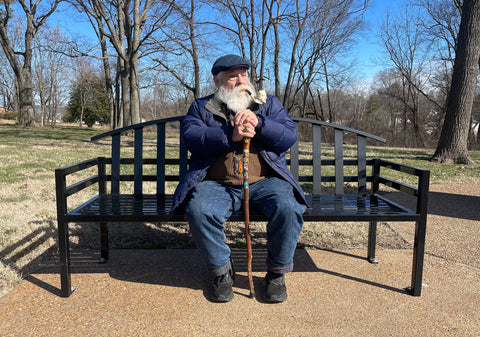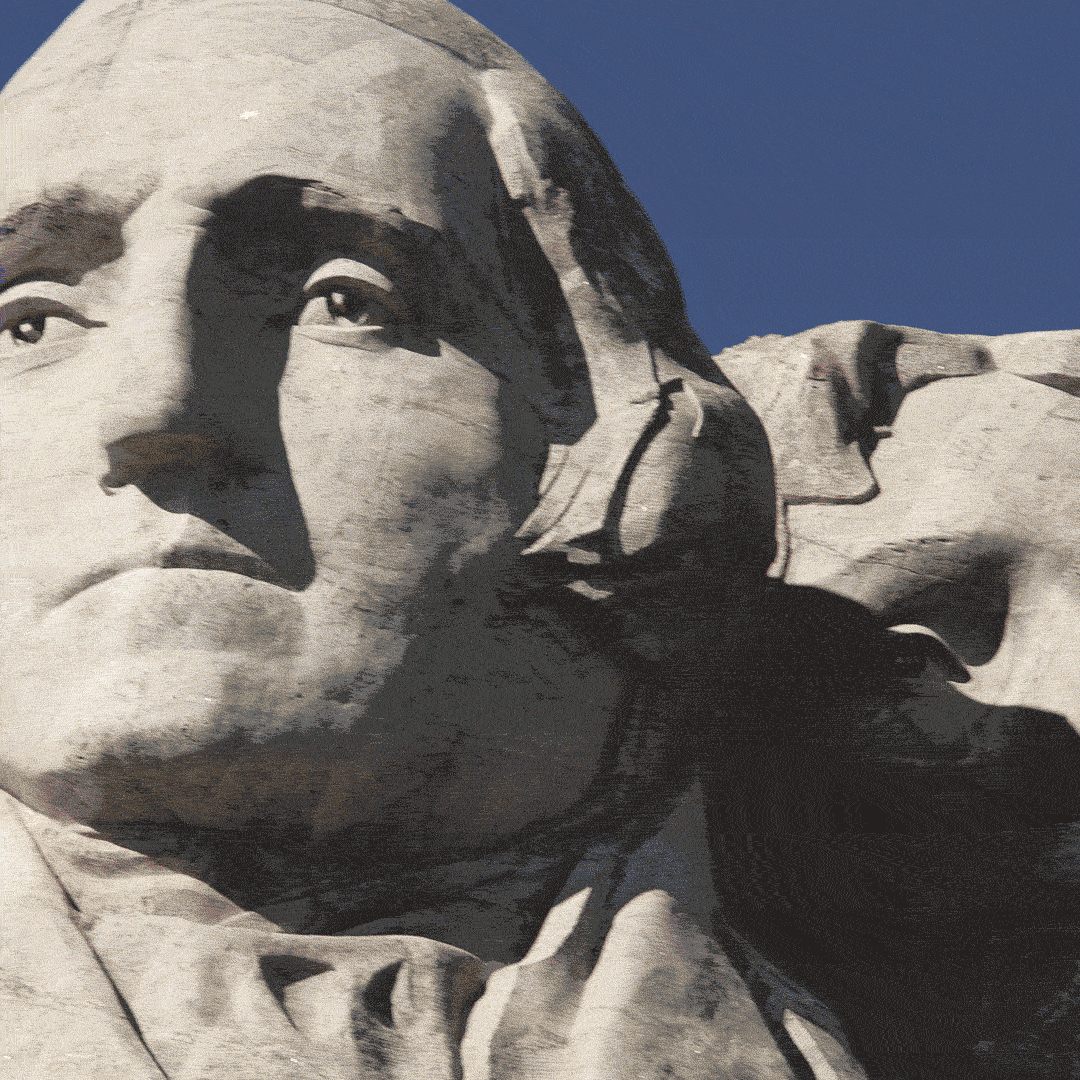
The Sage of Tennessee: The Volunteer Guide Who Brings the Battle of Franklin to Life
On a brisk morning, Chuck Byrn and I plop ourselves on a bench that often serves as his refuge from the 21st century. During the Battle of Franklin, Tenn., on November 30, 1864, the ground before us became a hellscape of bloody and broken bodies and shattered lives. A decade ago, two pizza restaurants and other urban schlock stood here. Now it’s a small park thanks to remarkable work by battlefield preservationists.
As two American flags flutter nearby, Byrn and I swap Civil War stories and a few fibs. He’s proud of his Jewish heritage as well as the Algonquin, Cherokee, Creek, Welsh, Scotch Irish, and Spanish in his blood. The 68-year- old Tennessee native—a retired history teacher, Grateful Dead and Doors fan, and docent at the historic Lotz House nearby—is also 100 percent character. I relish character , characters , and beards like Byrn’s milky-white extravaganza.
And Civil War stories, too. Byrn dispenses his in shotgun-like bursts.
In between tokes of house blend whiskey tobacco from his epic, carved Richard Nixon meerschaum pipe, he tells me about another character, Franklin’s own “Miss Annie.” Annie May Gatlin was her full name—her home once stood across Columbia Pike near the Fountain Carter House, vortex of the battle. She liked to remind Byrn that her grandaddy fought at Franklin and Confederate Brig. Gen. Otho F. Strahl died in her backyard.
In the late 1970s, Byrn served as a docent at the Carter farmhouse, which remains a popular battlefield attraction today. The bullet-riddled farm office yards away served as the de facto battlefield visitors center. Byrn remembers bullets from the battle filling a large terra cotta bowl there. Before he began his Sunday shift, Byrn would visit “Miss Annie,” who served him mai tais.
“And this woman could pour one ,” Byrn says while a cloud of smoke from his pipe drifts into the cool Tennessee air.
Good gawd, we all need a “Miss Annie” in our lives.
Besides a mai tai buzz, Byrn’s docent shift sometimes included a surprise or two. A man once beckoned him to his car and opened the trunk, revealing a bayonet wrapped in a near-pristine Goodyear rubber blanket from the war. The edged weapon, the man insisted, lay atop the belly of his 20th Tennessee ancestor, Colonel Bill Shy, who died at the Battle of Nashville. The blanket, he said, wrapped Shy’s body.
“Mind-blowing,” Byrn says.
Byrn recalls another visitor, a man in his late 90s, who said he had lived in the Carter House in the early 1900s.
“We couldn’t walk barefoot out in the yard without stepping on bone fragments and teeth,” the old man told Byrn.
On Friday, Saturday, and Sunday, Byrn works at the Lotz House astride the Columbia Pike. During the battle, the frightened Lotz and Carter families and others huddled in the Carters’ basement while the gates of hell opened outside. In a pivotal moment of the battle, Colonel Emerson Opdycke’s brigade charged past the Lotz House to plug a hole in the U.S. Army line.
About 70 minutes before his shift starts, Byrn readies the Lotz House for visitors. Then, carrying a bacon cheeseburger, coffee, and his ornate cane, he walks the short distance for a respite in the park. Yards away from his bench are foundation stones of the old Carter cotton gin, all that remains from the landmark that stood only yards behind Union lines. After parking himself on the bench, Byrn envisions a beautiful Indian summer day in November 1864.
For a few minutes, Byrn blots out the sound of all modern intrusions. Then he imagines the thunderous roar of gunfire of this often-overlooked Western Theater battle. The five-hour brawl resulted in roughly 8,500 casualties—2,300 for the U.S. Army, 6,200 for John Bell Hood’s Army of Tennessee. It was one of the rare Civil War battles fought almost entirely at night.
“Thousands of screaming Confederates were rushing toward us right here,” Byrn says, pointing his cane toward a modern, residential neighborhood. Behind their earthworks, Union soldiers five and six deep fired into the charging mass.
The bullet-riddled Carter family office that was
within the Union lines testifies to the ferocity of Franklin. “It was
impossible to exaggerate the fierce energy with which the Confederate
soldiers…threw themselves against the works, fighting with what seemed the
very madness of despair,” recalled a Federal soldier.
Often alone and deep in thought during these park visits, Byrn occasionally hears a strange rustling behind him. But no one’s ever there. Sometimes he even smells sweaty horses. We both marvel at the humanity lost in this small park.
Near us, in front of the 6th Ohio Light Battery position that’s marked today by two cannons, the “ground was literally covered with human bodies,” a 104th Ohio soldier remembered.
Another Union soldier said he “could scarcely walk without stepping on a body.”
Near U.S. Army earthworks, a Union soldier recalled a poor Confederate soldier begging “for the love of Christ” to have a pile of corpses pulled off him.
Another Ohioan recalled the dead “laid in every position imaginable.”
On this cloudless, deep-blue sky morning, a couple walks their dog over the same ground, near a gravel pathway that marks the line of Union earthworks. It is surreal.
If we expand our scope just a little beyond the park, tragic stories lurk everywhere.

The HistoryNet Box : Goodies for history lovers, curated by our editors, delivered every season—straight to your door.
To our right, across Columbia Pike, 20th Tennessee officer Tod Carter fell near his boyhood home. The 24-year-old soldier died in the house where he was born.
Across Cleburne Street in front of us, near a monument of faux cannonballs forming a pyramid, Irish-born division commander Patrick Cleburne suffered a mortal wound. Confederate soldiers found the general the next morning, his kepi partly covering his eyes.
In the far distance to our left, in the heart of what today is another modern, residential neighborhood, bullets riddled Brig. Gen. John Adams. He charged the Federals’ line astride his white steed, “Old Charley.” Strahl, Adams, and Cleburne—the “Stonewall of the West”—were three of the six Confederate generals to suffer mortal wounds at Franklin. All of them have streets named after them near where we sit.
Byrn especially admires Tod Carter, Adams, and Cleburne—“good God what balls he had,” he says of the Irishman—but prefers to focus on the “Willies and Joes.” That’s his term for the common soldiers who often reside in the shadows of history.
“I can feel their presence everywhere here,” he says of them.
One of those “Willies and Joes” is Henry Walters Cowman, a private in the 175th Ohio. The bushy-haired Cowman was just a kid, eight months shy of 17, when he enlisted in September 1864. He apparently lied about his age. Mom was a widow. Henry’s older brother, John, served with the 2nd Ohio Heavy Artillery.
At Franklin, the 175th Ohio’s first battle of the war, a bullet crashed into Cowman’s right arm —“over where the Bunganut Pig is today,” says Byrn. It’s a popular restaurant/beer joint about 50 yards behind us. Perhaps Cowman suffered the wound in his regiment’s desperate charge to the front.
“I tell you papa, that was a trying time for new men but I thought there was a chance for a new laurel so I started and so did all the rest,” a 175th Ohio soldier recalled of the charge. “Papa, I went mad, I did not think of danger.”
Cowman’s sister helped care for Henry in a hospital in Jeffersonville, Ind., where the teen died from a gangrene infection on January 24, 1865.
Day Elmore of the 36th Illinois, left, was mortally
wounded at Franklin. Henry Cowman was 16 years old when shot in his arm at
Franklin. The wound got infected and killed him in 1865.
Day Elmore of the 36th Illinois is another of Byrn’s boys. A farmer, he enlisted as a drummer in August 1861. Like Cowman, he was just a kid, only 17 when he joined the army. Elmore stood 5-foot-4 and had dark complexion with brown eyes and brown hair. In a wartime image, he posed with a Colt New Model Revolving rifle that was nearly as tall as he was.
At Chickamauga in September 1863, he suffered a serious lung wound. At Franklin, he suffered another wound, this time fatal. Elmore died a little more than a week after the battle. He was 20.
George W. Heckman of the 104th Ohio was in the fight at the cotton gin. The private is one of Byrn’s guys, too.
Heckman’s son, Walter, served in the U.S. Army during World War I. Decades after the war, he became a liaison for WWI veterans for the VA in Nashville. In 1970, Walter—who grew up in a Grand Army of the Republic orphans’ home—told stories about his dad to Byrn and his mother.
“Brother Heckman,” Byrn calls his fellow Mason.
That’s how close we are to the Civil War.
Before we depart his refuge, Byrn points to a photo on a historical marker.
“Don’t forget about him,” he says.
The image is of a bull terrier named Harvey, the beloved mascot of the 104th Ohio—“The Barking Dog Regiment.” The unit had several dogs, raccoons, and at least two squirrels as pets.
Byrn loves Harvey, mascot of the 104th Ohio. The
handsome pup, shown on a battlefield marker, survived the fight at Franklin,
and so did his master.
Despite the 104th Ohio’s precarious position at Franklin, Harvey somehow survived. So did his master. It was a rare glimmer of sunshine amid the gloom of late November 1864.
“I love Harvey,” Byrn says.
Then, pipe in his mouth and cane in hand, he returns to the Lotz House. For now, Byrn leaves his haven and the spirits of the “Willies and Joes” behind but never forgotten.
John Banks is author of three Civil War books. Check out his latest,A Civil War Road Trip of a Lifetime (Gettysburg Publishing). Banks frequently posts to his Civil War Facebook page,John Banks’ Civil War blog.
